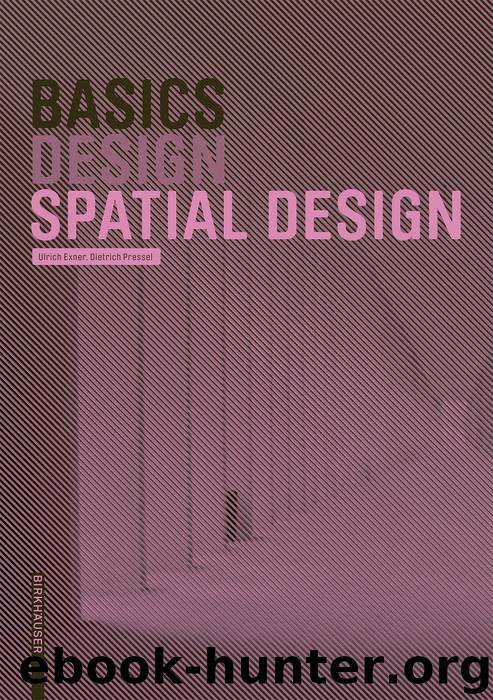Basics Spatial Design by Ulrich Exner

Author:Ulrich Exner
Language: deu
Format: epub
Publisher: Birkhäuser
Published: 2017-04-09T16:00:00+00:00
Context The environment or an existing building’s given attributes form the context. An architectural structure can use these site-specific atmospheric qualities or features as the design’s points of reference. > Fig. 45
Fig. 45: This new spatial structure refers to a container docks situation; the design focuses thematically on the principle of stacking.
Urban, historical, or social situations can serve as contextual references. The existing uses and situations of a particular environment, such as shopping opportunities or a busy street as a source of disturbing noise, all influence planning a spatial program, and thus, the design of a new construction.
Whether and/or how a building can produce individual contexts from spatial relationships is also a means of design. The context can be obscured by a closed, solid wall, or strategically included by making openings in the structure. In this way, a window with a view to the sea creates a reference to a landscape. If this is missing, part of the environment is obscured, thereby denying a reference to this aspect of the context.
The contextual reference can be read in the form of a building, in its material qualities, or in its spatial program. Using local building material is also a reference to the environment. The color and texture of a building constructed in this material resembles neighboring structures and is well assimilated. In addition, the dimensions or building form determine whether the structure will be well assimilated by or form a contrast to the given context.
Download
This site does not store any files on its server. We only index and link to content provided by other sites. Please contact the content providers to delete copyright contents if any and email us, we'll remove relevant links or contents immediately.
| Automotive | Engineering |
| Transportation |
Whiskies Galore by Ian Buxton(41879)
Introduction to Aircraft Design (Cambridge Aerospace Series) by John P. Fielding(33064)
Small Unmanned Fixed-wing Aircraft Design by Andrew J. Keane Andras Sobester James P. Scanlan & András Sóbester & James P. Scanlan(32743)
Craft Beer for the Homebrewer by Michael Agnew(18140)
Turbulence by E. J. Noyes(7936)
The Complete Stick Figure Physics Tutorials by Allen Sarah(7307)
Kaplan MCAT General Chemistry Review by Kaplan(6867)
The Thirst by Nesbo Jo(6827)
Bad Blood by John Carreyrou(6552)
Modelling of Convective Heat and Mass Transfer in Rotating Flows by Igor V. Shevchuk(6391)
Learning SQL by Alan Beaulieu(6211)
Weapons of Math Destruction by Cathy O'Neil(6146)
Man-made Catastrophes and Risk Information Concealment by Dmitry Chernov & Didier Sornette(5921)
Digital Minimalism by Cal Newport;(5664)
Life 3.0: Being Human in the Age of Artificial Intelligence by Tegmark Max(5474)
iGen by Jean M. Twenge(5366)
Secrets of Antigravity Propulsion: Tesla, UFOs, and Classified Aerospace Technology by Ph.D. Paul A. Laviolette(5309)
Design of Trajectory Optimization Approach for Space Maneuver Vehicle Skip Entry Problems by Runqi Chai & Al Savvaris & Antonios Tsourdos & Senchun Chai(5011)
Pale Blue Dot by Carl Sagan(4912)
